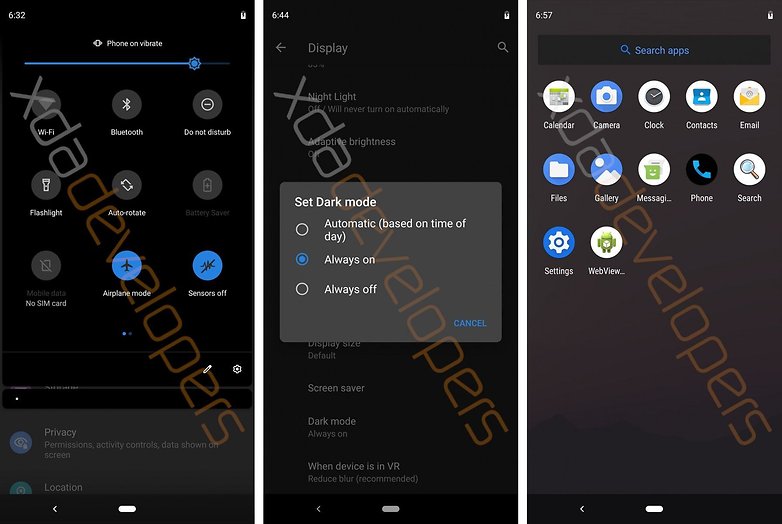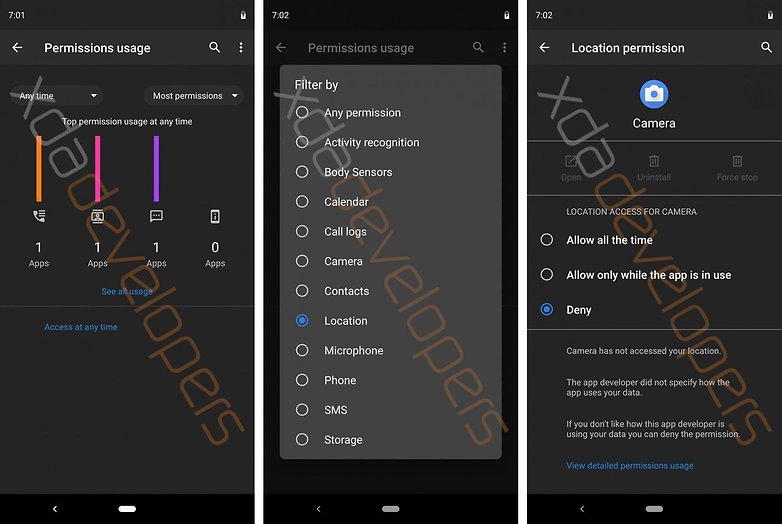Android Q: new features of the future version revealed


It won't be long until the first preview of Android Q. Attentive observers will find out in advance what new features are waiting for us. Recent discoveries include native Face unlock, app downgrades and other limitations for background apps.
Android Q: latest news
Native Face Unlock
XDA developers and 9to5Google have independently found evidence that Google will add facial recognition to Android's native biometrics. This should not be confused with the smart lock component Face Unlock, which was part of Google Play services. With native face recognition, Google could replace the typically less than secure vendor implementations, which are easy to outwit.

No clipboard access for background apps
The XDA developers have also discovered that Android Q wants to prohibit apps running in the background from reading the contents of the clipboard. So far, texts, images and passwords are stored in the main memory so that all running apps can easily read along and possibly send the data. Finally, this quasi-security gap has been closed.
App-Downgrades
In the same article, the XDA developers also show that a rollback of app updates is possible. You might then be able to undo an app update. This can help if the new version of an app is full of advertisements, crashes or runs worse than the old one.
Android Q: what we know so far
- Release in summer, preview in spring
- System-wide dark mode
- Revised permission management
- Desktop mode
- Developer options
- Assisted dialling
Release in summer, preview in spring, name sometime in between
If Google is aiming for a similar schedule as last year, we can expect a first developer preview of Android Q in March 2019. The stable version should roll out for Android One devices and Google pixel smartphones around August. Sometime before that, the name and mascot will be revealed.
System-wide dark mode
A dark system-wide theme had so far been denied to Android users. Instead, we've had to make do with dark launcher and hope that apps also support the energy-efficient and eye-friendly mode. But for Android Q, a system-wide dark mode could finally arrive to eliminate the need for this patchwork approach.
For the first time at the end of October 2018 an indirect confirmation on the part of Google was discovered by AndroidPolice in the bug tracker of Chromium. There the product manager Lukasz Zbylut wrote the following:
Dark mode is an approved Q feature. The Q team wants to make it possible for all pre-installed apps to support dark mode from the beginning. In order to successfully integrate dark mode, it is necessary that all UI elements ideally have a dark background by May 2019.
In the Android Q version, which was fed to the XDA developers, the implementation of a system-wide dark mode could now actually be tested.

This confirms the hope that we will find this mode in the official preview and later in the final version of Android Q. It should be located in the display settings. If you activate the mode manually, depending on light or time, not only the system surface will be darkened. Compatible apps can also change their existing color profile according to the system settings.
Rahman also discovered a developer option to force dark mode in incompatible apps, which was however associated with display errors. App developers will be able to use them to optimize their apps one day in the official Developer Preview.
The native dark mode for Android Q will hopefully make annoying work-arounds like manufacturer themes or mods like Substratum superfluous. Instead, Google will unify the rules by which app and UI developers can unify dark presentation in the system interface, as well as in apps. The bottom line is that the user will benefit.
Revised permission management
Android Q will also make the administration of active permissions more straightforward. Not only should the overview of be simplified, but your app should also be able to prohibit the use of permissions in the background. So DriveNow, MoBike and Co. can only locate you when you are actively using the app. Or WhatsApp may only listen to your microphone when you have the chat app open in front of you.

Google will thus counteract the often justified fear that individual apps can create profiles of their users in the background or permanently listen to them. A similar functionality is already available with the app Bouncer.
Desktop mode
Do you know of the Samsung DeX or Huawei Easy Projection projects? They allow smartphones to be used as a PC replacement. However, these isolated solutions could also soon be replaced by an official and uniform one. However, it is only a useless switch in the developer options so far. Rahman could not test any real functionality with it, let alone show it.
Developer options
Rahman found dozens more new points in the developer options, the functions of which remain obscure so far. Among other things, he speculates that:
- Apps in Andorid Q are better displayed in windows
- Screen contents can be recorded natively as video
- Always-on displays can be configured uniformly
What is assisted dialing?
Thanks to the Android Open Source Project (AOSP) and the editors over at XDA Developers, a feature of the successor to Android P may have been discovered. In the AOSP gerrit, after taking a closer look at the code, there is apparently a clear hint that Android Q will have assisted dialing.
This function corrects any phone number dialed by adding the specific country code. It was developed for those travelling internationally and is of course very useful if you are spending a lot of time abroad. It's important to note that Assisted Dialing is not an Android-specific feature, and has already been utilized by Google in its Pixel 2 devices, which were recently implemented with this assisted dialing when Google Phone v15 arrived.

In order to make these kinds of features from Google devices available to the majority of Android devices, we have to wait for them to arrive to AOSP first, and this process could take some time. From this fact, we can guess that assisted dialing will be available to all devices after being added into the Android Framework.

// Ceiling set at P because this feature will ship as part of the framework in Q. @VisibleForTesting public static final int BUILD_CODE_CEILING = 28;
After the code was further examined by the guys at XDA, it is clear that it’s referring to Android Q specifically. The target has been changed to Android Q, which apparently could be due to Google needing more time and therefore having to postpone assisted dialing to the Q release, rather than P.
Of course, this element isn’t the most exciting that could be highlighted, as it’s far less interesting than ones introduced with the release of Android Oreo, such as picture in picture mode, adaptive icons and notification channels. Nevertheless, it will be a useful one for the avid traveler. As always, we can never be certain whether the final version will have this feature.
For the time being, it does seem counterproductive to pay any attention to this version when we are still awaiting the roll-out of Oreo to many devices, and the arrival of the developer preview for Android P. We’ll keep you updated with all of the latest developments in the coming months for each version.
Are you even interested to know about Android Q this soon? What sweet treat could the letter Q stand for?
Source: XDA Developers, AndroidPolice, Chromium Bug Tracker




















That's a great news ?
This would be a great feature. Honestly I'm not sure why, with all the benefits, dark mode isn't the default and people have to choose the "hurt your eyes and waste battery" mode as an option.
Because OLED isn't the most common screen panel in use but the only panel that gets this benefit
Still im waiting for OREO update
Running Android 9.0 Pie ? on Mi A1
wowzers. no one really even has oreo yet, and they are already planning android q? nonsense